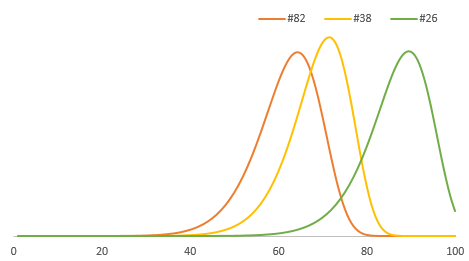I get it, but I think you are missing my point. I'll try rephrasing a bit.
Just because you draft a guy at a spot doesn't necessarily make that number his value. So for example, when Seattle drafted James Carpenter at #25 in 2011, did they really think he was the very best player available at that time? No, but he was the best OL available and Seattle had made up their mind to draft OL come hell or high water. In terms of big board value, Carpenter was more along the lines of a 35-40 type pick.
This is why JS wanted to trade down so badly in 2011, because he didn't think Carp was actually a #25 overall value. Cue Nick Saban in the audience shaking his head as the pick was announced...
If we are talking about range of possibilities for James Carpenter (green line) vs the picks acquired in a trade (yellow and red), you'd have to adjust the green curve from #25 to #35 to get a more accurate picture of Carpenter's value. And if you did that, then suddenly trading down looks like a no-brainer. This is why JS wanted to move down so badly, and why he had such a hard time finding a trade partner.
Now I'll give you an example of the opposite.
In 2014, Seattle owned the #32 pick, fresh off a SB victory. Going into the draft, Teddy Bridgewater was widely considered to be a top 15 pick, and was even in the running to go #1 overall. However, when the draft occurred it set up a situation, much like Rodgers in 2005, where the teams that all needed QB picked super early and had other players ranked just barely ahead of Bridgewater. Once Bridgewater lasted to the mid-1st round, all the teams that needed QBs had already picked, so he had a free fall all the way to the end of the first round.
Now he's sitting there at #32. Seattle doesn't need a QB. But Minnesota does. To Minnesota, Bridgewater was a top 15 player who through unique circumstances fell to #32. In their eyes, they were getting much more than a #32 pick by trading up with Seattle. The result was the Seahawks getting a fairly generous offer to move down a few spots, good enough for them to forgo a shot at heralded guard Joel Bitonio.
Whether Bridgewater lives up to his potential or not is not really my point. My point is that Bridgewater's real value on big boards was a lot higher than where he was actually drafted. And so if we are looking at a probability distribution for Bridgewater, it would be misleading to compare him to 'typical' players selected #32 overall, since if Bridgewater had gone #10 overall, nobody would have blinked an eye.
NFL teams generally view a players value based on where he sits on their big board, not on where that player is actually picked. This sometimes sets up whacky scenarios where GM's "build their draft" around a mid-round player who rates very highly on their big board, but due to odd circumstances, can be had much later. Russell Wilson is the classic example of this.


